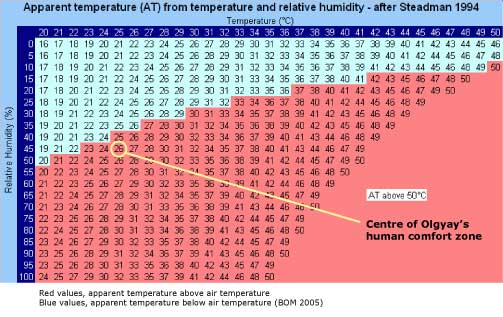The key variables defining human thermal comfort can be combined into one indicator called the Apparent Temperature (AT). AT is a heat index invented in Australia in the 1970s by a researcher named Robert Steadman.
Many factors contribute to human perception of thermal comfort. The four main environmental factors are wind, temperature, humidity and radiation from the sun or nearby surfaces. Of these, wind and radiation are microclimatic factors; they are influenced by local factors such as aspect, shelter from wind, shade, nearby surfaces and so on. As such, they are best measured on site, rather than generalized for a region.
Temperature and humidity can be combined into one index and used to compare different areas, or different times of year. Personal factors, such as clothing, acclimatization and level of muscle activity also influence comfort. AT takes this into account, and is modeled on an adult walking in either the shade or full sun (there are two formulas). The formula for the AT is:
AT = Ta + 0.348×e - 0.70×ws + 0.70×Q/(ws + 10) - 4.25
Ta = Dry bulb temperature (°C)
e = Water vapour pressure (hPa) [humidity]
ws = Wind speed (m/s) at an elevation of 10 meters
Q = Net radiation absorbed per unit area of body surface (w/m2)
Where
e = rh / 100 × 6.105 × exp (17.27 × Ta / (237.7 + Ta))
rh = Relative Humidity [%]
The table below shows the AT for different combinations of temperature and relative humidity. For example, at a temperature of 23°C, we feel a temperature of 27°C when humidity is 80% or 20°C when the humidity is 15%.
This variable makes the model fairly simple. The switch from needing ‘cool shade’ to ‘warm shade’ occurs when the AT is 26.5°C. This corresponds to the AT in the center of Olgyay’s bioclimatic chart of human comfort (25°C and 45% relative humidity). The table below shows how important humidity is in determining thermal comfort. It also shows that the WebShade model is able to equate different combinations of humidity and temperature to the same levels of heat perception.

|

